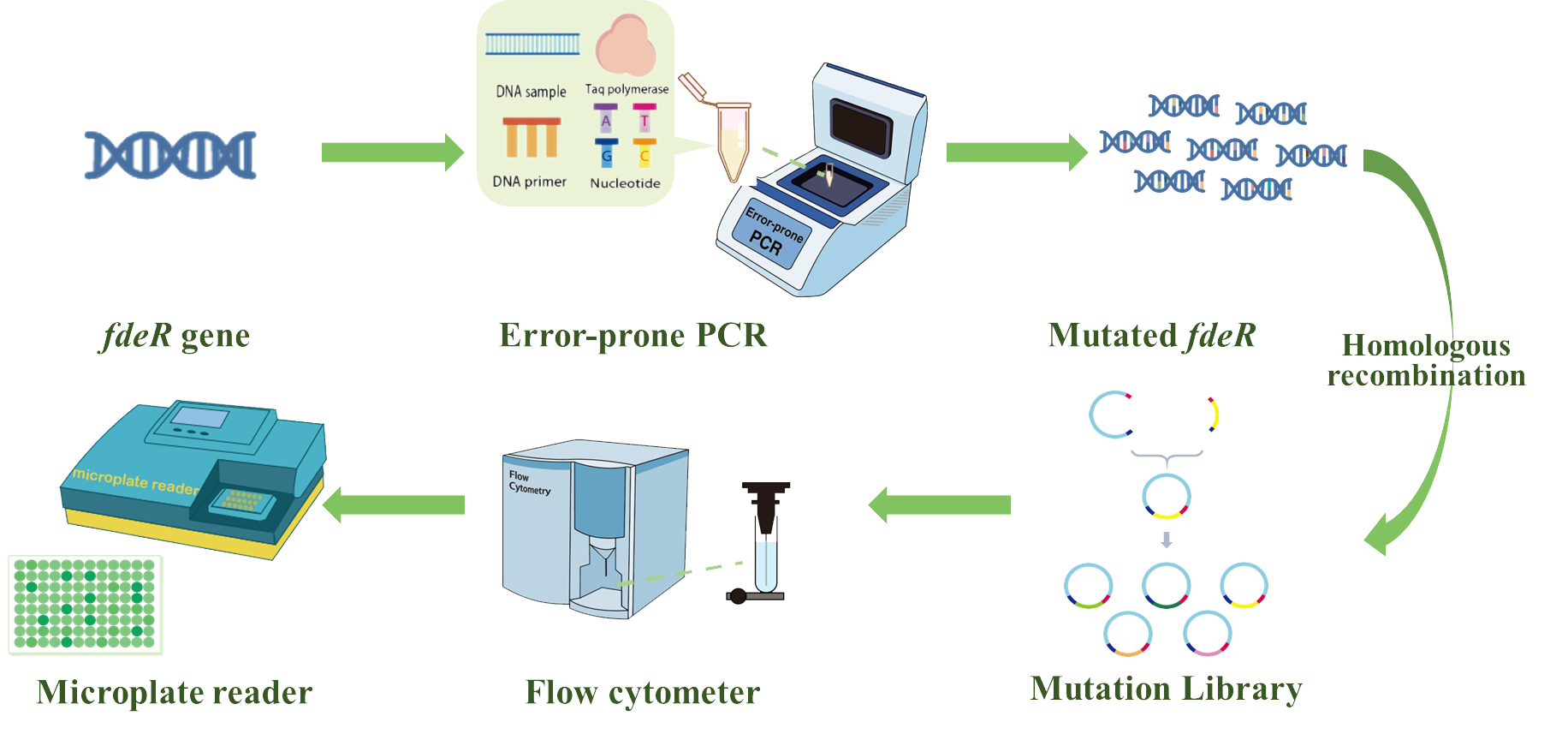



Mutation libraries were constructed through error-prone PCR and site-directed mutation and phage-assisted continuous evolution (PACE). Among them, mutants produced by error-prone PCR and site-directed mutation were screened by a flow cytometer (Figure 1), and mutants produced by PACE were screened by the device of PACE (Figure 2).

Figure 1. General fluorescence screening schematic.

Figure 2. Overview of phage-assisted continuous evolution (PACE) strategy.
As a basis of this study, pQE-80L-fdeR was designed and constructed, based on the reported sequences of the PfdeAR-FdeR native regulatory circuit from H. seropedicae. 1
The pathway consists of detection module and effect module. The detection module contains an artificial constitutive P22 core promoter and the fdeR gene, while the effect module contains the bidirectional promoter PfdeAR with eGFP downstream of it. A random nonsense DNA spacer and terminator were inserted between P22 and PfdeAR so that transcription initiation by bidirectional promter PfdeAR in the fdeR gene direction was blocked to ensure a clear division of the two modules (Figure 3A).

Figure 3. Schematic representation of the collection of synthetic FdeR biosensors.
Through the above design, we can use the fluorescence intensity to represent the potential capability of FdeR to bind with liquiritigenin. In the absence of liquiritigenin, FdeR can bind to PfdeAR to inhibit the expression of eGFP. In the presence of liquiritigenin, FdeR binds to liquiritigenin causing its conformation changes, thus allowing the expression of eGFP (Figure 3B and 3C). Figure 4 confirms the feasibility of the screening pathway and demonstrates the optimized potential of the biosensor with FdeR as the detection module.

Figure 4. The dose-response curve of wild-type FdeR to naringenin and liquiritigenin.
PACE is a high-throughput and time-saving strategy.2,3 During the PACE process, host cells flow continuously in the lagoon and are infected here by selection phage (SP) containing mutant library. Functional library members bind liquiritigenin and initiate transcription of the downstream T7 RNAP gene on SP, which ultimately allows the AP to produce pIII and release progeny capable of infecting new host cells, whereas non-functional library ones do not. Random mutations occur in all genes of the host cell and phage under the induction of drift plasmid (DP).
We designed a specific PACE system allowing the continuous directed evolution of riboswitches through both positive and negative selection pathways.
In the positive selection, if the ideal mutant binds to liquiritigenin, allowing T7 RNA polymerase to be translated normally, thus T7 RNA polymerase can initiate gIII expression, and enable the phage to propagate normally. The activity of mutants can be reflected by eGFP expression. To obtain mutants with higher activity, selection pressure was gradually increased by reducing the concentration of anhydrotetracycline.
For the negative selection, pIII-neg, a dominant negative mutant of pIII, is used to impair the infectivity of newly born phages. When adding naringenin instead of liquiritigenin, if the mutant responds to naringenin, T7 RNA polymerase can be translated normally and activate gIII-neg expression. Even with gIII expression, the phage cannot propagate properly. After positive and negative selection, the riboswitch's affinity for liquiritigenin was enhanced, while its binding capability for naringenin was decreased.

Figure 5. PACE positive and negative screening pathways.
1. B. De Paepe, J. Maertens B. Vanholme et al, Modularization and Response Curve Engineering of a Naringenin-Responsive Transcriptional Biosensor. ACS Synth Biol 7, 1303-1314, (2018).
DOI: http://doi.org/10.1021/acssynbio.7b00419
2. K.M. Esvelt, J.C. Carlson D.R. Liu, A system for the continuous directed evolution of biomolecules. Nature 472, 499-503, (2011).
DOI: http://doi.org/10.1038/nature09929
3. S.M. Miller, T. Wang D.R. Liu, Phage-assisted continuous and non-continuous evolution.Nat Protoc 15, 4101-4127, (2020).
DOI: http://doi.org/10.1038/s41596-020-00410-3